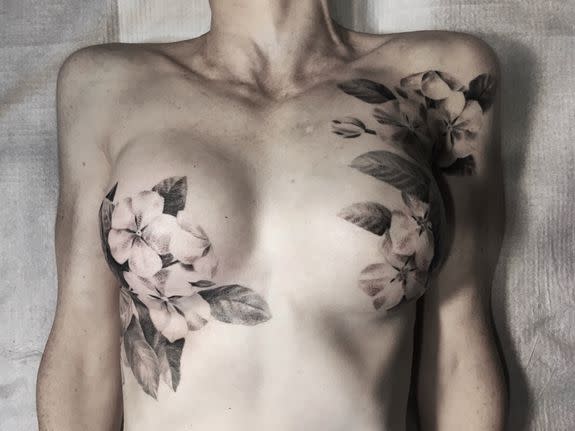Tattoo artist beautifully explains why women cover their mastectomy scars

Every mastectomy scar is unique.
The way it feels and looks depends on the woman who is wearing it, and what her body endured before and after the removal of one or both breasts.
SEE ALSO: Breast cancer survivor gets tattoo over scars, ends up falling in love with the artist
Tattoo artist David Allen has spent the past few years learning these complex intricacies. In that time, he's adorned several dozen cancer survivors with chest tattoos of plants, flowers and branches to give their scars new meaning — and the women who bear them a newfound sense of beauty and agency.
"They’ve gone through a process where they’ve lost control," says Allen. "The beauty is that they're in control of this."

Image: david allen
Allen, who is based in Chicago, laid out his philosophy and technique in an article published Tuesday in the Journal of the American Medical Association. After a profile of his work appeared in the Chicago Tribune last fall, the journal invited him to write about his work for its regular column about the intersection of the arts and medicine.
"The women with breast cancer with whom I work share a feeling that they’ve been acted upon — by cancer, the health industrial complex and its agents, the sequelae of their treatments," he writes.
Most of Allen's clients have never been tattooed. He spends a lot of time learning about their cancer and its scars. The conversation is deeply personal and often turns to whether or not they felt heard by the doctors who treated them. Allen believes his role is to listen and understand what aspects of a woman's scar she wants to cover and develop a design that is both practical and symbolic.
When women look at their scarring, which include the removal of the nipple and reconstructive surgery, he says they often use the same word: Frankenstein.
"They [feel] pieced together," Allen says. "It’s beautiful we can do it, it’s amazing we can do it. But the identity is lost."
That identity can be wrapped up in sexuality or femininity. For mothers who breastfed, the loss of a nipple or breast can erase a connection they felt to their children.
The way Allen uses botanical imagery has a few advantages. First, it doesn't require outlines filled in by color. Instead, he describes his technique as pointillism that is both efficient and minimally traumatic. A typical tattoo often relies on 11 or more needles to fill in outlines with solid color. Allen draws a hard outline with just five to nine needles, and uses a rotary machine that doesn't emit the same drilling noise as a standard tattoo machine.

Image: david allen
Images of flowers, plants or trees can also be easily revised over time, particularly if a woman needs to have additional surgeries or is re-diagnosed with cancer. If there's new scarring, he can add another leaf or branch to cover it, whereas geometric shapes or text aren't so forgiving.
But the symbolism of covering a scar with images from nature, he says, is its own form of healing.
"Even if the land has been ravaged, life comes back," Allen says, describing his own philosophy that has been complemented in some unique way by every woman he's tattooed.
One woman wanted roses because her grandmother grew them. Another woman who gardened said one of her plants began to die when she was diagnosed with cancer. A tattoo of that flower was her way of bringing it back to life.
"[T]he symbolism of quiet, inexorable change and growth evoked by flowering plants fits where the women are in their journey through and away from their illness," Allen writes in the essay.
Some women who are interested in a tattoo aren't ready for one, and Allen recognizes that. When he touched a woman's chest and she began crying, because she hadn't been touched by a man in years, Allen decided it wasn't the time to begin his work.
His chest tattoos cost between $800 and $2,000. Each project, he says, requires empathetically partnering with a breast cancer survivor looking to assert control over life and body.
Allen's JAMA essay seemed to encourage clinicians, who may deliver diagnoses over the phone or spend just 10 or 15 minutes with a patient at every appointment, to think of their patients as partners deserving of compassion — not just medical treatment.
"Everyone sees themselves so differently," he says. "I want to know your story and I want to hear it. That right there is the crux for me — it's the empathy."
